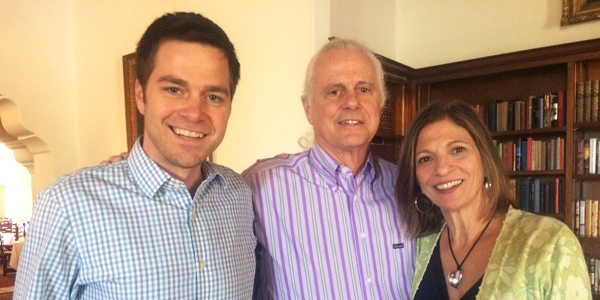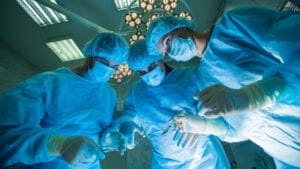Life stopped suddenly for Tucsonan Richard “Dick” Highberger at 40,000 feet, when a silent and devastating cardiac arrest left him not breathing and with no heartbeat during a flight over Texas.
Within moments, however, three vascular surgeons with ties to the University of Arizona Department of Surgery were at his side, saving Highberger’s life in the cramped aisle of a regional commuter jet.
“We are still stunned,” said Highberger, 64. “If you are going to have something like this happen, you should have three vascular surgeons sitting 10 feet away. I couldn’t have planned it any better. Everything happened almost perfectly, with the best medical care right there.”
Said his wife, Jan Highberger, “We as a community can be proud of the UA doctors.
UA vascular surgery resident Craig Weinkauf, MD, PhD, said the incident was life altering for him. “It was great to help someone and be so lucky that it happens to be a couple that is so wonderful and happy,” Dr. Weinkauf said.
The Highbergers and Dr. Weinkauf recently met for lunch, where they celebrated life and chatted for more than two hours. The couple presented the young surgeon with a donation to help fund research he is taking part in at the UA.
In a stroke of good fortune, the Highbergers and the three vascular surgeons, including Miguel Montero-Baker, MD, from Pima Vascular, and John Pacanowski, MD, chief of vascular surgery at Tucson Medical Center, who also are adjunct faculty at the UA College of Medicine – Tucson, boarded the United Airlines flight in Houston on April 12. The bleary-eyed surgeons, after traveling all night, were on the last leg home to Tucson, returning from a vascular surgery conference in Bogota, Colombia.
Jan Highberger, a physical therapist, had attended a conference in Houston and the couple visited Dick’s family over the long weekend. After the couple took their seats, Dick shut his eyes to doze. About 30 minutes into the flight, Jan knew something was wrong.
“His face didn’t look right,” she said. “I called his name and he didn’t respond. I called for help and the three of them were right there.”
Dr. Weinkauf, 34, said the situation was dire. “By the time I got near Dick, he looked dead,” Dr. Weinkauf said. “I work in the intensive care unit and you see people who are coding. He was white; he wasn’t breathing and had no carotid pulse.”
They asked the flight crew to land the plane as soon as possible and went to work.
“Craig was very reassuring,” said Jan Highberger, who is trained in CPR. “He said they were all UA surgeons and they had it covered. I just had to sit and hope and pray.”
The surgeons struggled to get the long, lanky frame of the cyclist to the aisle floor. Dr. Montero-Baker held is head stable to optimize his airway, and Dr. Weinkauf made sure his upper airway was not blocked. An airline attendant rushed in with the plane’s defibrillator, and Dr. Pacanowski aided in life-saving efforts.
“The aisle was so narrow, I couldn’t even fit on my knees – I had to lay flat on my belly to keep his airway open,” said Dr. Montero-Baker. “Craig had to straddle him to do chest compressions. It was spectacular to see everyone moving and working together.”
“I ripped off his shirt and put on the pads,” Dr. Weinkauf said. “He had a rhythm called ‘pulseless electrical activity,’ which means his heart still has some electrical activity, but it wasn’t functional enough to create an actual pulse. It can’t pump and that is a non-shockable rhythm.”
Dr. Weinkauf started chest compressions, and after about 50, checked for a pulse. It was weak, but to his surprise, Highberger’s heart was beating. “He has a pulse, man,” Dr. Weinkauf said to his friend and colleague Dr. Montero-Baker. “He was just barely breathing on his own.”
Dr. Montero-Baker was relieved to see him turn from white back to pink.
The doctors gave Highberger oxygen in the chaotic scene. Because his heart now was beating, chest compressions were suspended, although the defibrillator loudly called for continued compression.
“If someone has a pulse, you are only going to hurt them by doing chest compressions,” said Dr. Weinkauf, who admitted the young surgical team might have looked more like a rock band than surgeons, dressed in jeans and t-shirts. “It was the loudest thing on the plane and all the passengers kept yelling, ‘Guys, do chest compressions!’ I finally just shut the machine off.”
The plane made a quick descent, adding to an already tense situation.
“As we hit the airstrip at a really quick speed, we were all sliding down the aisle and the other passengers grabbed my boots so we would not slide all the way down,” Dr. Montero-Baker said.
In what seemed like record time, the plane landed in Austin.
“The pilots did a great job,” Dr. Weinkauf said. “From the time we said we need to land I don’t think it was more than 10 minutes.”
While Highberger’s pulse and respiration were improving, the doctors were concerned he might not survive. Fortunately, the plane landed near the Level 1 trauma center at University Medical Center Brackenridge.
Dr. Weinkauf believes had all three surgeons not been on the plane, Highberger would not have survived. “The fact that Miguel and I work together meant we really never had to communicate. We both knew what to do.”
Dr. Montero-Baker agreed. “If we were not in that plane, he would have died. This reminds you of how frail ultimately we are as human beings. I think there is a reason he’s around. There were a few angels there to take care of him, and I hope someday angels are there for me,” Dr. Montero-Baker said.
While Highberger struggled with four days of short-term memory loss, he appears to have no neurological damage. A pacemaker and defibrillator were implanted and the Highbergers were back in their Tucson home within about a week.
Afterward, Dr. Weinkauf wished he had gotten the Highberger’s phone number, and the Highbergers wished they had gotten the surgeons’ names. Jan Highberger checked the UA surgery website, hoping to see familiar faces. She reached out to administration, wanting to thank the surgeons. An email was circulated, with no luck.
“I hadn’t told very many people,” said Dr. Weinkauf, who did not receive the email. “I told my parents and my close friends.”
Weeks later, he was telling someone at work and the connection was made. “It was so sweet and nice,” he said of their lunch together.
Dr. Weinkauf said the donation will be used to continue research into improved diagnostics and treatment of carotid vascular disease to prevent stroke.
“Craig is so warm and wonderful, and we really enjoyed getting to meet him,” Jan Highberger said. “There is so much bad news all the time but every day, people like Craig work to help others, and these people were so good and skilled.”
Highberger, who is retired, is enjoying his return to normal life, working around their home’s 10 acres and taking part in African drumming. “We are just so thankful for everybody who had anything to do with this,” he said.




